Messages on Postal Stationery Cards
The Beurs (stock exchange) Johannesburg
Jeff WoolgarFormal message on this Vürtheim postal stationery card
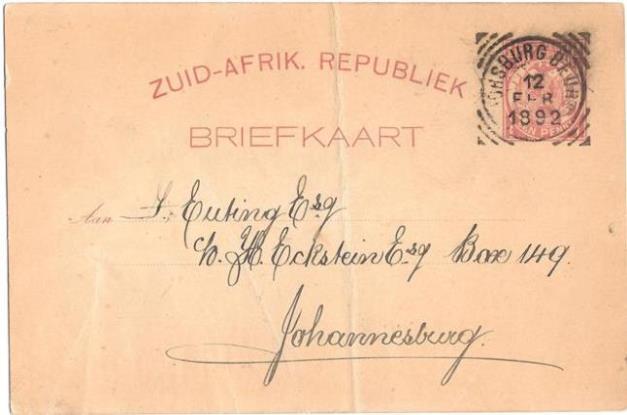
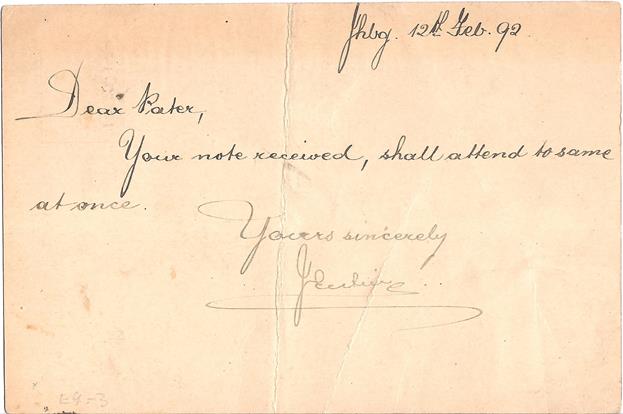
Formal message on this Vürtheim postal stationery card


The South African Republic one-penny Vürtheim postal stationery card has a 'squared circle inner circle broken' datestamp. (The inner circle has not inked on this example.) It was addressed formally from a Son to his Father at the De Beurs branch Post Office, Johannesburg on 12th February 1892 to a box number at the General Post Office in Rissik Street, also in Johannesburg. As the General Post Office was only a few streets away the addressee doubtless opened the post office box, read the message, folded it in half to fit his pocket, and went about his business - just a few hours later. The formality of this type of correspondence, between close relations, was common business practice into the 1960s.
This datestamp is interesting for it was about half way through 1897 there was a boom in diamond shares; it was then that some datestamps are also found with 'JOHABURG BEERS'. The 'U' of the 'squared circle, inner circle broken' datestamp being changed to an 'E'. De Beers is of course the renowned diamond company which still trades today. It was from July to September 1897 these can be found used from this branch office. It was assumed that a member of staff at the De Beurs Post Office managed to alter the datestamp lettering, perhaps as a hoax; which went unnoticed for a long period. However, it is also possible that somebody at the Beurs post office had a datestamp made just for the fun. It should be mentioned that these datestamps are not clear, the office would have been busy and on receiving an envelope few, if any, would have looked at the postmark, for it was the contents of the letter or message on a postal stationery card that was of importance. Later, at the end of December 1895 it is possible there was an attempt to remove 'BEURS' from the handstamp. These are but suggestions and not all researchers can agree, as damage to this datestamp may have been caused by wear.
The first datestamps were a single circle dating from April 1891 to September 1894 and a double circle with 'GEREGISTREERD' (registered) in the upper half from July 1895.
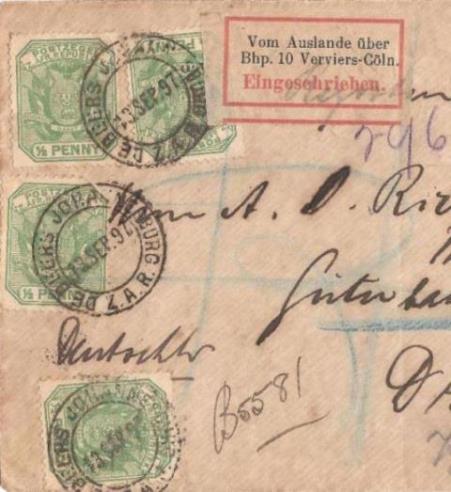
Above is a another datestamp, a double circle ‘DE BEURS JOHANNESBURG Z.A.R.’ with date, month and year of 13th September 1897. It was in used from July 1897 to September 1899.
The first Johannesburg Stock Exchange
Friction between interested individuals with investments in the Witwatersrand gold mines possibly delayed the organisation of a Johannesburg stock exchange until 16th January 1887. A single-storey building was constructed on the corner of Commissioner and Simmonds Streets. There was a central hall approximately 50 by 25 feet and 20 feet in height with circular-headed windows. The decoration of the interior was plain although there was a place for refreshments with a 'beautifully-fitted bar'. In spite of the optimism just over a year later, February 1898, this new enterprise was voluntary placed in liquidation.
A telegraph office was operating by April 1887; nevertheless the six or so staff and the equipment were inadequate for the volume of work - 500 wires a day.
The Second Stock Exchange
The foundation stone for the New Exchange was laid during November 1889. Designed by the company Lennox Canning & Goad and was opened in 1890, although used the eastern end of the building was only being completed in 1893. The building cost £70,000 and had its principle entrance, a porte-cochére, in Commissioner Street. The total length was 207 feet and depth being 100 feet along Simmonds and Fraser Streets, the later having seven shops while at the Simmonds Street end there were offices. The rectangular 'Exchange Hall' in the centre of the building measures 98 by 45 feet, and was 56 feet high. Unlike the first Stock Exchange this building was elaborately fitted, stained glass, and turned balustrades on the gallery which was 10 feet wide. To the west of the Hall was a large bar and refreshment room. The entrance halls had barrel-arched ceilings with stained-glass screens, and there being much parquet flooring in the offices and bar. On the first floor were another 40 offices, board room, library, and a showroom above the shop in Fraser and Commissioner Street. Various meetings and events took place in this building as there were few places large enough for many events in Johannesburg. These included chess when the market was quiet. Then there were services held by a Lutheran pastor, concerts, political meetings during elections, Council and Library Committee meetings and even a brass band on Christmas Eve. Underneath the Fraser Street shops was the post and telegraph branch office from 1891.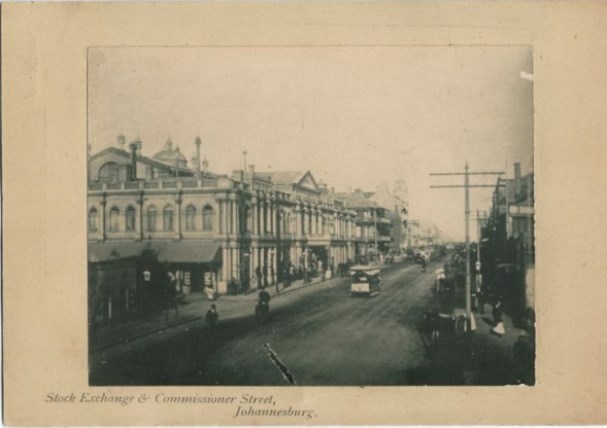 Despite there being dozens of picture postcards and a few illustrated postal stationery cards which show the Johannesburg Stock Exchange, none have been found showing Fraser Street on the west side of the building. Therefore, the postcard size card above is an undated Christmas card on which is pasted the picture; which must have been taken before December 1904. Here we see the corner of Commissioner and Fraser Streets. The shop on the corner had the showroom above and apparently De Beurs branch post office below.
Despite there being dozens of picture postcards and a few illustrated postal stationery cards which show the Johannesburg Stock Exchange, none have been found showing Fraser Street on the west side of the building. Therefore, the postcard size card above is an undated Christmas card on which is pasted the picture; which must have been taken before December 1904. Here we see the corner of Commissioner and Fraser Streets. The shop on the corner had the showroom above and apparently De Beurs branch post office below.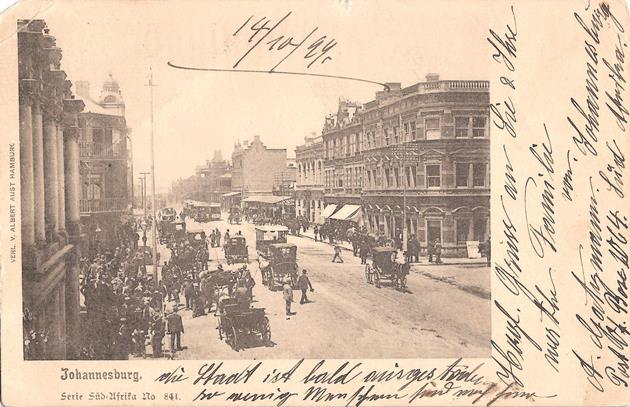
This picture postcard was published by ‘VERL. V. ALBERT AUST HAMBURG’ and is annotated “14/10/99”. Addressed to Germany and entered the postage system on the 16th October. (The outbreak of hostilities between the South African Republic and Britain took place on the 11th October 1899.) The view is looking east along Commissioner Street and was taken from the top of the porte-cochère (covered entryway).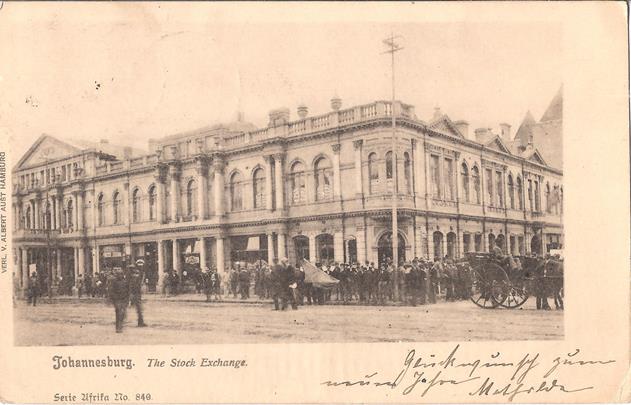 Another picture postcard published by ‘VERL. V. ALBERT AUST HAMBURG’ address to London entering the post at Krugersdorp on 3rd January 1901, with arrival datestamp for ‘LEE S.E.' on 25th January 1901. There are three postage stamps, two one-penny rose and green and a single green; all are overprinted ‘V.R.I.' Victoria Regina Imperatrix (Queen Victoria).
Another picture postcard published by ‘VERL. V. ALBERT AUST HAMBURG’ address to London entering the post at Krugersdorp on 3rd January 1901, with arrival datestamp for ‘LEE S.E.' on 25th January 1901. There are three postage stamps, two one-penny rose and green and a single green; all are overprinted ‘V.R.I.' Victoria Regina Imperatrix (Queen Victoria).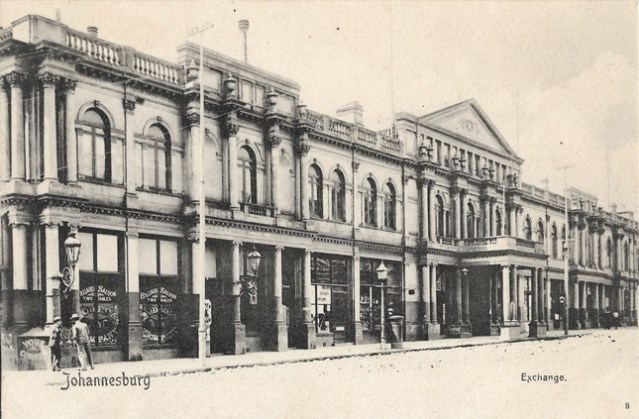 The publisher of this unused picture postcard with an undivided back is unknown. Although, this was a per-war photograph dating for circa 1895 and the postcard from 1899. The illustration displaying the porte-cochère (covered entryway) in Commissioner Street.
The publisher of this unused picture postcard with an undivided back is unknown. Although, this was a per-war photograph dating for circa 1895 and the postcard from 1899. The illustration displaying the porte-cochère (covered entryway) in Commissioner Street.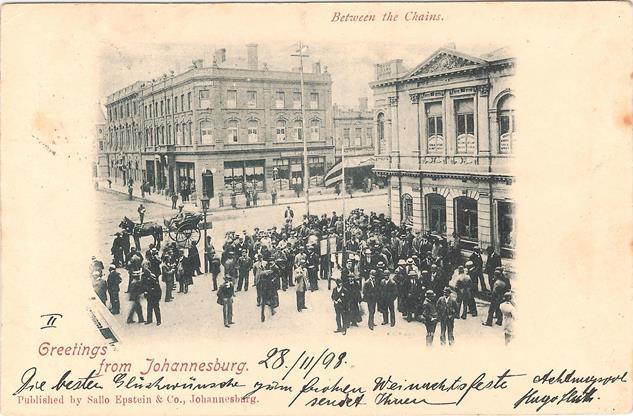 The South African Republic one-penny, rose and green illustrated postal stationery card was posted in Johannesburg to Austria on 28th November 1898, arriving in Wien on the 20th December. Here we see Simmons Street looking towards Commissioner Street during ‘High Change.
The South African Republic one-penny, rose and green illustrated postal stationery card was posted in Johannesburg to Austria on 28th November 1898, arriving in Wien on the 20th December. Here we see Simmons Street looking towards Commissioner Street during ‘High Change.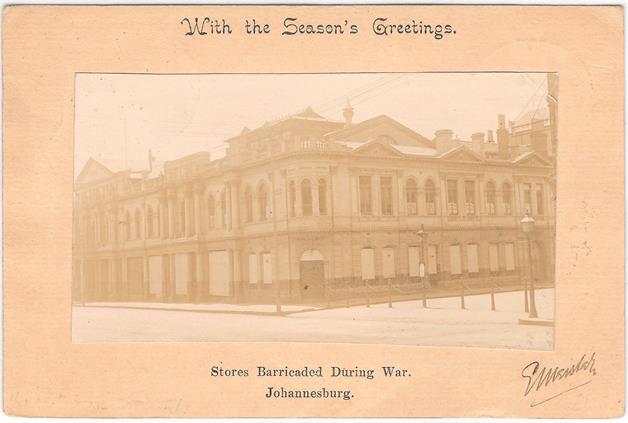 Used as a Christmas card to Germany. The half-penny disselboom postal stationery card has been upgraded with a two-penny disselboom postage stamp; both overprinted 'V.R.I. Addressed to Germany it entered the post in Johannesburg on 23rd November 1900. The arrival datestamp for Bremen on 15th December 1900. The captions on the back are printed in a brownish old-gold, and the mounted sepia photograph is of the Johannesburg Stock Exchange, showing the ground floor windows boarded with sheets of corrugated iron.The photograph was taken from Commission Street, and shows part of Simmons Street and the area known as 'Between the Chains', where business was conducted after 'High Change' in happier days. The first Bollards were rough wooden poles linked by chains across the road. In mid-1892 a pair of gas lamps were added and a sign affixed to each, which read, 'Fastening horses to the chains is forbidden'. However, this is not the sign shown in the picture. 1894 saw the replacement of the poles with cast iron bollards.Overseas markets dictated the times of the Johannesburg Stock Exchange. Therefore, the so-called "High Change" which dates from 1888 was the prescribed time for calling over the stocks in alphabetical order from 10.30. Therefore, the main attraction in the afternoon was the sight which took place between the chains, in Simmonds Street. Where hundreds of brokers and buyers were to be found.‘Between the Chains’ became so well known in southern Africa that Maria Watermeijer composed a barn dance called ‘Between the Chains’; thus this unique open-air share market became known around the world.Acknowledgments
Used as a Christmas card to Germany. The half-penny disselboom postal stationery card has been upgraded with a two-penny disselboom postage stamp; both overprinted 'V.R.I. Addressed to Germany it entered the post in Johannesburg on 23rd November 1900. The arrival datestamp for Bremen on 15th December 1900. The captions on the back are printed in a brownish old-gold, and the mounted sepia photograph is of the Johannesburg Stock Exchange, showing the ground floor windows boarded with sheets of corrugated iron.The photograph was taken from Commission Street, and shows part of Simmons Street and the area known as 'Between the Chains', where business was conducted after 'High Change' in happier days. The first Bollards were rough wooden poles linked by chains across the road. In mid-1892 a pair of gas lamps were added and a sign affixed to each, which read, 'Fastening horses to the chains is forbidden'. However, this is not the sign shown in the picture. 1894 saw the replacement of the poles with cast iron bollards.Overseas markets dictated the times of the Johannesburg Stock Exchange. Therefore, the so-called "High Change" which dates from 1888 was the prescribed time for calling over the stocks in alphabetical order from 10.30. Therefore, the main attraction in the afternoon was the sight which took place between the chains, in Simmonds Street. Where hundreds of brokers and buyers were to be found.‘Between the Chains’ became so well known in southern Africa that Maria Watermeijer composed a barn dance called ‘Between the Chains’; thus this unique open-air share market became known around the world.Acknowledgments
I thank Gail Tompkins for her guidance concerning private correspondence.References
Payne, B., and Visser, A., ZAR and Transvaal date-stamps until Union: a working catalogue - Part 1: Aangewljs to Bisley, The Transvaal Philatelist, (205) March 2020, p.44.Reisener, H. O., 1976, [First published 1975], De Beers in Johannesburg?, The Transvaal Philatelist, (43) August 1976, pp.71-73.Rosenthal, Eric, (1968), On ‘Change though the years, A History of share dealing in South Africa, Johannesburg, pp.135-200.Sotheby’s Auction of postage stamps and postal history, with early ‘De Beurs’ covers; Tuesday, 5th July 1983 in Johannesburg from 7.30pm.Africana Aantekeninge en Nuus / Africana Notes and News, Africana Museum, Johannesburg, Vol.25, no.7, September 1983, p.258.
Copyright © 2025 Jeff Woolgar
- - o - -